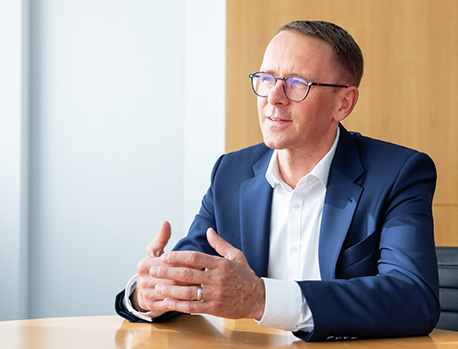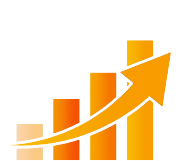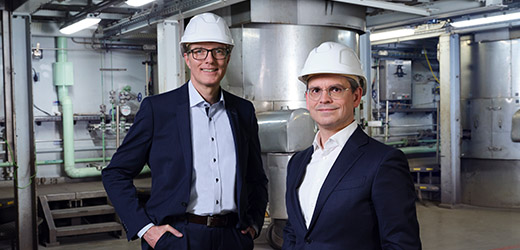Strategy
“Spirit, Speed and Confidence Are Our Recipe for Success”
WACKER has set itself clear goals until 2030. Annual Group sales are to exceed 10 billion euros with an EBITDA margin over 20 percent. CEO Christian Hartel discusses the road ahead, the levers available to the company to achieve its goals, the focuses of the individual business divisions and what makes WACKER resilient in times of permanent change.

President & CEO of Wacker Chemie AG
Mr. Hartel, WACKER has been pursuing new strategic goals since last year, with Group sales planned to rise to over 10 billion euros by 2030. You yourself spoke of accelerated growth when you presented the strategy in London. How does the company plan to achieve this?
CH: Our strategy until 2030 centers on accelerated growth because, in view of the successes we have achieved hand in hand with our customers over the last decades, we are confident of achieving such a growth rate. We do actually see many opportunities for further growth. For us, the chief priority is to advance this accelerated growth: by increasing investment in additional production capacity but also in R&D – across the world.
Despite the war in Ukraine, the sharp rise in energy and commodity prices, and high inflation, WACKER has still broken records over the past fiscal year: 8.2 billion euros in sales and an EBITDA of about 2.1 billion euros. Given the figures, aren’t the 2030 targets rather on the conservative side?
CH: First of all: 2022 was an outstanding year for WACKER. These remarkable earnings were the result of our customers’ strong demand but also the WACKER team’s strong engagement. Our strategy until 2030 is a guideline to orient ourselves by. We want to grow sales to over 10 billion euros. But we can’t just assume growth will be linear, of course. We performed very well in 2022. But there will certainly be some years between now and the end of the decade when progress will be more difficult. Nevertheless, we are convinced that we can achieve our goals. And another point: our sales target is over 10 billion, not exactly 10 billion. So there is still scope to dream big.
Since the war in Ukraine started, there has been much discussion about economic dependence. What is WACKER’S strategy to make itself less dependent on individual regions or countries?
CH: The issue of economic dependence is very much in the media spotlight due to the Ukraine conflict. But it’s nothing new for us. In fact it has preoccupied us for many years. At WACKER, we have always kept our portfolio as broad as possible. Both on the customer and the supplier side. If only because this puts us in a better negotiating position and enables us to compensate for business fluctuations more effectively. That is why we have pursued a strategy of diversification for many years. We have always deliberately and systematically shied away from dependency on individual business partners. And we will continue to do so in the future.
“At WACKER, we have always kept our portfolio as broad as possible.”
Can you give an example of dependencies in the past that WACKER has successfully resolved?
CH: Silicon metal is a good example. This is a key raw material for us, because silicon forms the basis of three quarters of our products. We have done a lot here in recent years, First, we have integrated backwards. In 2010, we were able to acquire a silicon production facility in Norway, which we then expanded step by step. Today, we cover about one third of annual demand through our own production. Second, we have systematically optimized and expanded our portfolio of silicon suppliers over recent years. WACKER is one of the biggest purchasers of silicon metal, and we now source it worldwide. It helps us to leverage the potentials of different regions and avoid becoming dependent on individual suppliers
Higher investment plays a crucial role in WACKER’s strategy. In your view, which projects are of greatest importance?
CH: We are clearly targeting organic growth through our own resources. And that means we need additional production capacity. This applies to all business divisions and it applies worldwide. It is in regions outside Europe where we can see particularly high growth opportunities. That is why we will be investing more strongly there, in Asia, but also in the Americas. Silicones are a prime example of this. We want to become No. 2 in the USA in this business. And that means we will be increasing our investment spending in US production capacity in order to serve our customers there even better.
We see big opportunities in this region, not only for our chemical business but especially for a high-value product where we are already the global market leader – polysilicon, a hyperpure material for, in particular, semiconductor applications, as well as extremely efficient monocrystalline solar cells. Above all, we will continue to invest in polysilicon for the semiconductor industry in order to continue supplying our customers worldwide with the best material available on the market.
Finally, there is WACKER BIOSOLUTIONS, which is our newest business division but one with exceptional growth potential. Our goal here is to achieve annual sales of 1 billion euros by 2030. To achieve this, we will step up investment in the further expansion of our existing capacities.
1 billion euros in sales at WACKER BIOSOLUTIONS is an ambitious goal. It will mean tripling today’s revenue over the next eight years. What role will acquisitions play in this?
CH: That’s true. “1 billion from Bio,” as we call the goal in house, is certainly ambitious. But we are convinced it’s feasible. First, because we can see many opportunities in this segment. And second because we have performed very well here in recent years.
The additional growth in this segment is based on three pillars. The first pillar is expanding our existing skills and capacities – in both pharmaceuticals and ingredients for dietary supplements. To this end, we want to expand our sites in Amsterdam, Halle and Jena in Germany, and Eddyville in the USA – all four at the same time.
The second pillar is innovation. WACKER BIOSOLUTIONS is focusing on developing new products. Equally important for us are research projects, which, in the second step, move into production and marketing.
And the third pillar that plays an important role is collaboration. I expect dynamic growth here in the coming years. We will also be looking at acquiring more companies in order to further expand our capabilities as well as develop our production sites.
It is this combination of expanding our existing capabilities, developing new and innovative products, and pursuing collaborations and acquisitions that we will use to drive the growth of our biotechnology business.
Do you already have your sights set on possible acquisition targets?
CH: For years, we have had a list of attractive candidates that we update regularly. So this is nothing new. We are looking very closely at companies that could be potential acquisitions. It is important that their technology fits in with our portfolio. The corporate culture, the people, must also be compatible with us. This is an important point for successful integration. And finally, of course, the price must be reasonable. So hold your breath! We have a number of interesting candidates on our list and we will see one or other acquisition in the next few years, I think.
Sustainability is another key building block in your strategy. WACKER plans to halve its CO2 emissions by 2030, and wants to be net zero by 2045. What stage are you at so far?
CH: Here, we are very much on the right track. We published these absolute targets at the end of 2021, specifically for reducing carbon emissions. I am firmly convinced that such ambitious goals are necessary to fuel the momentum within the company to achieve them. We are already seeing the results. There is no end to the new ideas that have been generated since we formulated these goals. And we find it exciting that very many colleagues are firmly convinced that this is the right direction for us.

-50%
emissions
We have a clear roadmap for achieving our sustainability goals. A major building block is our silicon production site in Norway. We have now switched over entirely to green energy there. In the coming years, moreover, we will source the carbon that we need for manufacturing from renewable raw materials.
“The high energy prices are a key challenge for the coming years.”
The third step is then to capture the CO2 resulting from production. To store it and perhaps also to use it as a raw material for chemical products. Conversion of silicon production in Holla is a very big lever in our sustainability agenda to achieve our goals. Two-thirds of our products already help our customers to meet their sustainability targets. We continue to see huge growth potential for our business here.
WACKER has just had two very successful years. Where do you see the biggest challenges for 2023?
CH: I think we’ve seen great challenges in the last two years and to some extent in the years before that. Especially in Europe when it comes to energy supply. Competitive energy prices are of paramount importance for WACKER as an energy-intensive company. We have done a great deal in recent years and decades to continuously improve our energy efficiency. And I know we are world leaders in many areas here.
Nevertheless, we need internationally competitive prices in our energy supplies. Higher energy, raw materials and logistics costs wiped more than 1.3 billion euros off our income last year. The good news is that we have been able to compensate for this to a large extent through greater efficiency and higher prices for our products. But in principle, the international competitiveness of Germany in particular and Europe in general is still at stake here. The high energy prices in Germany are a key challenge for the coming years. This applies not only to our company and to the chemical sector, but also to many other industries in Europe.
The second challenge this year is the economy. In Europe, we are in a recessionary environment, and as an individual company, we cannot completely decouple ourselves from this, of course. In this respect, one challenge for 2023 is certainly the overall economic trend in Europe, in the Americas and, of course, also in Asia.

Mr. Hartel, you have said in the past that one of WACKER’s success factors is a high level of resilience with regard to international developments – i.e. trade conflicts, high energy prices, supply chain disruptions and rising interest rates, to name just a few factors. How resilient is the company today?
CH: I think that today we are in a very stable position. This is most obvious when you look at our financial figures: we have generated a high net cash flow. In the last three years, this amounted to a total of around 2 billion euros. We are debt-free, reporting net financial assets of more than 400 million euros. This gives us flexibility on the financial side and, of course, that is important for the resilience of our company.
However, three other points are important for our resilience. First, that we do the things we are good at and what we are also well-known for in the market. However, we are not resting on our laurels, but are constantly improving and becoming more efficient.
Now to the second point and this is very, very important: our proximity to customers. That means that we develop and manufacture products and solutions that the customer needs and will continue to need tomorrow. We listen to customers, pump large resources into development and also have a presence right where the customers’ needs are. That is a strategy we have pursued at WACKER for decades. We have consistently promoted the regionalization of our activities, while constantly expanding and developing our technical centers and production sites worldwide. I believe that this is a very good and stable set-up, especially in today’s world, which is undergoing a certain amount of upheaval: not being tied to a single location, but in touch with our customers at many different places around the world.
“We want to be the architect of our own success.”
The third point, which I find very important and essential, is that you have to believe in yourself, in your own organization. I’ll put it in a nutshell: spirit, speed and confidence. That’s what we need to succeed. WACKER has these qualities. Our actions are supported by our strong foundation. We have a long-term approach and act responsibly. “We want to be the architect of our own success.” This takes spirit, speed and confidence. And we will continue resolutely along this path.





